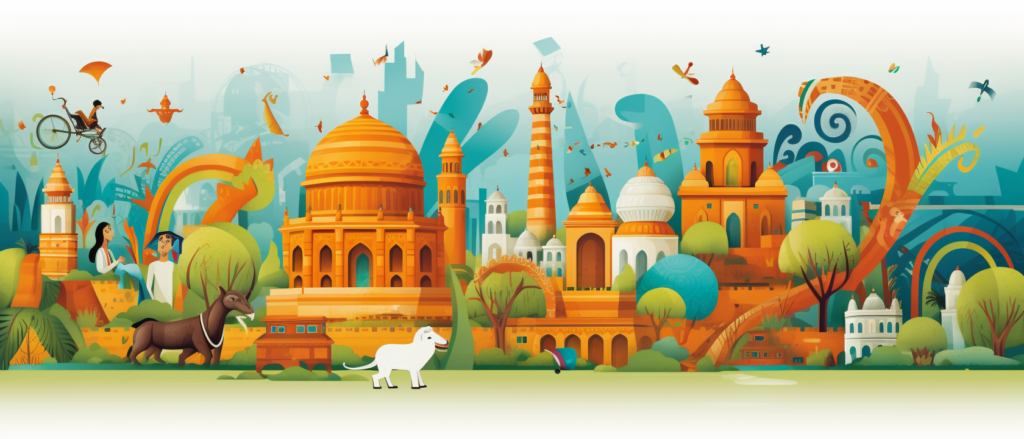Key Takeaways
✅ Understanding the Indian Audience and Search Behavior: Diving into SEO in India? Get this: To win big, you’ve got to get the local crowd. Focus on what they’re searching for, whether it's in Hindi, Tamil, or any of the myriad languages spoken across the subcontinent. Did you know that regional interests vary as wildly as the local cuisine? Tailoring your content to these preferences can make your website the go-to spot for Indian searchers.
✅ Mobile-First Approach: Hold up, did you check how your site looks on a smartphone? Because here's the deal: most folks in India are probably visiting your site from one. It's not just about looking good; your site's got to be quick and slick, because no one likes to wait around for pages to load. Ever heard of AMP? If not, now's the time to tune in because it could give your site the speed boost it craves.
✅ Localization and Regional Targeting: Picture India as a world of its own, with each neighborhood dancing to a different beat. Your SEO strategy needs to embrace this diversity. Are you mentioning local landmarks, festivals, or events? Are you playing nice with local directories? If not, you might be missing out on tapping into communities eager for what you've got to offer.

Introduction
Ever wonder why some websites pop up like shining stars in the Google.in sky while others lurk unseen in the digital shadows? The secret sauce is SEO, tailored especially for the vibrant and varied landscape of India. SEO in India isn't a one-size-fits-all deal—it's an intricate dance of tactics that resonates with the locals.
Feel like you're whispering into the wind when you should be headlining the marquee? This guide is about flipping that script. From delving into the minds of Indian searchers, to crafting a site so mobile-friendly it practically jumps into users' hands, we've got the insider info that could transform your digital presence from overlooked to overbooked.
Ready to ride the wave of technical SEO, create content that engages like a Bollywood blockbuster, and measure your success with the precision of a master jeweler? Stay tuned, as we unfold a treasure map of actionable insights that'll have you ruling the roost on Google.in and watching your audience—and revenue—grow like never before. Hold onto your hat; we're diving headfirst into mastering SEO in India.
Top Statistics
| Statistic | Insight |
|---|---|
| Internet User Growth: Over 696 million active internet users in India as of January 2021. (Source: Statista) | With such a vast and ever-expanding pool of netizens, can you imagine the potential reach your website could have? |
| Market Share of Google: Google has a dominating 94.33% of the search engine market in India as of December 2020. (Source: StatCounter) | A glimpse at this number and you'll know—Google.in is where you want to shine, right? |
| e-Commerce Growth: The market is expected to grow by 21.5% annually, reaching $111.40 billion by 2024. (Source: Statista) | The e-commerce explosion is real, and it's not slowing down. Are you getting ready to claim your share? |
| Mobile Traffic: 69% of website traffic in India came from mobile devices in 2020. (Source: Statista) | This stat begs the question: Is your website mobile-friendly? Because that's where your audience is at! |
| Digital Marketing Boom: The industry in India is expected to grow at a CAGR of 27.7%, reaching $160 billion by 2025. (Source: IBEF) | Digital marketing is booming—it’s soaring, actually. Isn't it time for your brand to ride the wave? |
Understanding the Indian Searcher
Think about a bustling market full of folks looking for all sorts of things. Now, put that scene online, and you've got something like the Indian internet space. It's a world brimming with various interests and cultures, and Indian internet users have their unique way of searching for what they need. Have you ever wondered what people in India look up on the internet? Well, their common search queries range from local news to Bollywood and cricket highlights. There's also a big push for things like online shopping deals and educational content. And let's not forget, in SEO, you've got to be like your neighbor's aunty – always knowing what's happening locally. Localization and cultural sensitivity make a huge difference if you want to connect with people here.
Optimizing for Google.in
You know, Google.in isn't just Google.com wearing an Indian kurta; there are some differences indeed. Now, you might ask what these differences are and how to tackle them? First off, tailoring your website to suit the Indian searcher is like cooking a local dish – you've got to get your spices right. This means using local language content – not just Hindi, mind you, but also Tamil, Marathi, and other regional languages that resonate with your audience's hearts. And remember, your website content shouldn't just translate, it should culturally translate – there's a huge difference.
Technical SEO for Indian Websites
Alright, let's get a bit techy but stay casual. When you're setting up your website, think of it as setting up a shop. The structure and navigation of your website are your shop's layout – you want people to find what they need without getting lost. And hey, we all hate waiting, so make sure your site is as fast as a street food vendor whipping up a quick bite, meaning it must have great website speed and mobile responsiveness. With more people browsing on their phones, your site needs to be as mobile-friendly as a chaiwala at a train station. And don't forget the toppings – schema markup and structured data can really make your site stand out to search engines.
Content Marketing for SEO in India
Picture this: you’re telling stories around a campfire, capturing everyone's attention. That's what content marketing for SEO in India is all about. Your content needs to be like your grandmother's tales – full of substance, excitement, and a local flavor. So, creating high-quality, relevant content for Indian audiences is like making your grandma's signature dish – it's got to have that authentic taste. Drawing on local influencers and social platforms can spice things up, too. In India, when it comes to SEO, don’t underestimate the power of voice in video and voice search; it’s like the chai's ginger, giving it an extra zing!
Measuring and Improving SEO Performance
In a country where cricket is almost a religion, keeping score is vital. The same goes for SEO – you need to know the key performance indicators (KPIs) to tell if you're hitting a six or just batting around the field. Tools like Google Analytics and Search Console should become your best friends. They are like umpires who never miss a beat, helping you track your site's runs and wickets. And just like cricket strategies evolve, your SEO game needs to be up to date to stay ahead of Google's algorithm updates. You can't just set it and forget it; you need to be on your toes, ready to adapt.
So you see, conquering Google.in isn't just about understanding the ABCs of SEO. It's about jumping headfirst into the vibrant Indian market, figuring out the tastes and preferences of local searchers, and giving them a user experience they'll come back for, just like a favorite family restaurant. Keep it personal, make it local, and stay agile - that's the real spice of SEO in India.
AI Marketing Engineers Recommendation
Recommendation 1: Optimize for Mobile First and Local Search: India has over 500 million smartphone users and counting. With more people accessing the internet via mobile devices than ever before, having your site mobile-friendly isn't just an option – it's a necessity. Google's mobile-first indexing means your mobile site is essentially your primary site in Google's eyes. Make sure your website is responsive, loads quickly on mobile devices, and features content optimized for local searches. For instance, including local landmarks and dialects in your content can help you rank higher for users in specific areas of India.
Recommendation 2: Leverage Voice Search Optimization: Voice search is taking off in India, especially with the growing use of digital assistants like Google Assistant. To tap into this trend, structure your content to answer questions people might ask in natural, conversational language. For example, using long-tail keywords in FAQs or creating content that directly answers common queries related to your business can significantly increase your visibility.
Recommendation 3: Implement Structured Data for Rich Snippets: With the competition to rank on Google.in being fiercely intense, securing a spot in rich snippets can be a game-changer. To enhance your chances, implement structured data (Schema Markup) on your website. This doesn't just help search engines understand your content better; it can also lead to better CTRs as rich snippets stand out in the SERPs. Tools like Google's Structured Data Testing Tool or Schema.org can guide you in how to properly set this up on your site. This is particularly beneficial for e-commerce sites where product information or reviews can be highlighted directly in search results.
Relevant Links
- Mastering SEO in India: A Comprehensive Guide
- Engage Digital India: Crafting Local Content for SEO Success
- Leverage AI for Revolutionary SEO and PPC Campaigns
- AI Marketing: Transforming Strategy, Content, and Customer Experience
- Navigate AI Trends: Top Digital Marketing Adaptations for 2024
Conclusion
And there you have it, the ins and outs of SEO in India. See, tackling Google.in isn't just about fitting keywords into your content. As we've walked through this journey together, it's clear that understanding the heartbeat of Indian search patterns and behaviors is crucial. Have you thought about how localization goes beyond language and dives deep into the cultural essence? It's what makes the content resonate with someone in Mumbai or a small town in Kerala.
Remember when we talked about getting your website ready, not just for any visitor, but for an Indian visitor? The technical tweaks that ensure your website loads swiftly on a smartphone in a crowded Delhi café—are you keeping those considerations in mind? How about the kind of content that stirs up conversations on Indian social media channels? India loves stories, are you telling captivating ones through your content, making it impossible for viewers to not hit the 'Share' button?
Adapting to the likes of Google.in means embracing the dynamic digital landscape of India, which is as diverse as its people. There's always something new, something challenging, and yet, something incredibly rewarding about mastering SEO in this vibrant market. And finally, keep measuring, learning, and growing. Is your website climbing up the search ranks? Are more people from India finding you? That's how you know you’re getting it right.
Now, it's your turn. Will you dive into the vast ocean of SEO opportunities in India, and steer your digital presence to capture the attention, hearts, and minds of millions? Because let's face it, on the other side of that SEO strategy could be a bustling crowd of eager customers just waiting to discover what you have to offer. So, are you ready to reach out and connect with them?
FAQs
Question 1: What is SEO, and why is it important for websites in India?
Answer: Think of SEO like the spices in a curry. It's that magic mix that gets your website to pop up first when someone's looking for something you offer. For sites in India, it's what gets you seen by a whole bunch of potential customers without having to spend a ton on ads.
Question 2: How does Google.in's algorithm differ from Google.com, and how does it affect SEO in India?
Answer: It's a bit like choosing the right masala for your dish. Google.in spices things up just for India, so your SEO strategy needs to hit the right notes with local flavors, languages, and what we all love here to get attention.
Question 3: What are the most important ranking factors for SEO in India?
Answer: Okay, so you know how you've got those go-to ingredients in your pantry that never fail? The same goes for SEO in India: great content, being mobile-friendly, lightning-fast loading, strong backlinks, and getting those tags on point. Don’t forget to sprinkle in some local language and social chatter, too!
Question 4: How can I optimize my website for voice search in India?
Answer: Ever tried talking to those voice assistants and got something totally off? To avoid that, make sure your website talks back like a human, uses phrases people actually say, loads quickly on phones, and has the answers to what everyone's asking.
Question 5: What is the role of social media in SEO in India?
Answer: It's huge! Imagine your brand is like a Bollywood star. The more it's seen and loved on social channels, the more it shines everywhere else, including in those search results.
Question 6: How can I optimize my website for local SEO in India?
Answer: You need to make sure people can find you not just online, but on the ground. Claim your spot on Google My Business, toss in some local keywords, get some local link love, encourage reviews, and guide those search engines using schema markup.
Question 7: How can I track and measure the success of my SEO efforts in India?
Answer: It’s like keeping score in cricket. You should be checking out how much traffic's coming in, where your keywords are batting on the rankings, how quick people bounce, and if they're sticking around or buying what you’re selling.
Question 8: What are the common SEO mistakes to avoid in India?
Answer: Don’t just stuff your content with keywords like it's a suitcase the night before a trip. Avoid cheap link deals that could get you into trouble, don’t ignore the technical bits, and keep your content fresh – stale content is like yesterday's samosas, not very appealing.
Question 9: How can I stay updated on the latest SEO trends and best practices in India?
Answer: Dive into SEO blogs, tune into webinars, and get social with SEO pros. Staying in the know is like keeping up with cricket scores; you have to stay on top of the game.
Question 10: What are some recommended resources for learning SEO in India?
Answer: You’ve got a library at your fingertips: Google's own guides, SEO-savvy blogs, online courses, and good old SEO books. And don't miss out on the local events – it's like a cricket match for SEO buffs where everyone learns from each other.
Academic References
- Sharma, S. K., & Pandey, R. K. (2014). Search Engine Optimization Strategies for Indian Websites: A Study. International Journal of Engineering and Advanced Technology, 3(6). This comprehensive study dives into the SEO tactics Indian websites can adopt to boost their rank on Google.in. Sharma and Pandey shed light on effective keyword research, maintaining high-quality content, and the power of tailoring your website to resonate with the local audience.
- Rao, V. V. S. K. S. S. R. K., & Murthy, K. S. S. R. (2017). Search Engine Optimization: A Study on Indian Websites. International Journal of Scientific Research in Computer Science, Engineering and Information Technology, 2(5). Tackling the intricacies of SEO for Indian websites, this study by Rao and Murthy spotlights the hurdles these sites face and maps out a detailed framework for optimizing them. The discussion extends from on-page technicalities to creating engaging content and building a robust link network.
- Murthy, K. S. S. R., & Rao, V. V. S. K. S. S. R. K. (2016). Exploring the Challenges and Opportunities in Search Engine Optimization for Indian Websites. International Journal of Advanced Research in Computer Science, 7(1). In this paper, Murthy and Rao unpack the SEO landscape for Indian domains by examining how cultural contexts and the diverse linguistic tapestry influence search engines' understanding of content, ultimately offering a unique angle on optimization strategies.
- Sharma, S. K., & Pandey, R. K. (2015). Search Engine Optimization for Indian Websites: A Study on the Effectiveness of Keyword Research Tools. International Journal of Advanced Research in Computer Science, 6(1). Focusing on keywords—the heart and soul of SEO—this research by Sharma and Pandey assesses various keyword tools to understand which works best for Indian market niches. The findings aim to guide content creators to make informed decisions in their SEO efforts.












